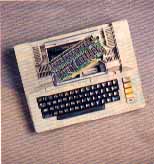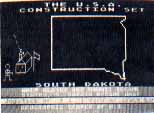Product Reviews

RAMCHARGER
Magna Systems
147-05 Sanford Ave, Suite 4E
Flushing, NY 11355
(718) 339-0908
$299.95, 1Mb for Atari 800
ALSO AVAILABLE:
(All 8-bit upgrades include MYDOS)
$149.95, 256K for 800
$199.95, 512K for 800
$100-$120, 256K for 800XL/1200XL
$120, 320K for 130XE
$180, 576K for 130XE
$280, 1088K for 130XE
$135-$150, 1Mb for 520ST
Reviewed by Charles Cherry
It is strangely satisfying to use an old Atari 800 with more memory than a 1040ST. In truth, RAMcharger extra memory has limited utility, but it, warms the heart to know that it is there.
Because the 8-bit Ataris can't use all this memory directly, 16K blocks of memory are switched around to fool the computer. Most programs are not designed to play this shell game and can't use the extra memory. For this reasan, most people configure the memory upgrades as an imaginary diskdrive--a RAMdisk. The RAMdisk works just like real disk drive--only bigger and much faster. Oh yes, the RAMdisk also forgets everthing as soon as the electricity stops, so copy your files to floppies before you switch off.
Bulletin board system operators will enjoy using a one-megabyte RAMdisk with over 8,000 sectors. So will programmers who work with compilers and macro assemblers--a huge RAMdisk speeds development very nicely. People who own a lot of unprotected programs will load their mega-RAMdisk and never turn off the computer --using RAMcharger as a very fast hard disk. Imagine, load any program instantly.
A few commercial programs will accept the extra memory as a larger workspace. Among them are SynFile + and SynCalc, which will use about 288K. PaperClip 2.0 will use 320K on the XL and XE only. Magna includes a patch to let AtariWriter Plus use 48K. If you have a third-party DOS, it will probably use some or all of the extra memory as a RAMdisk. MYDOS is included in the package and can utilize all the installed memory. Atari XL and XE computers will let you use BASIC XE with a RAMdisk.
The Atari 800 expansion is Axlon compatible. The XL and XE expansions are 130XE compatible. The ST expansion is, of course, compatible with the 1040ST. The XL, XE, and ST modifications require that you send your computer to the Magna factory. I tested the 1Mb unit for the 800. That gave my computer 1032K total memory, 32K more than a 1040ST.
This 1Mb upgrade for the 800 consists of one board which plugs into the middle 16K RAM slot under the top lid of this Atari model. The RAMcharger can be surrounded by standard 16K boards or a modified 32K board and the BIT-3 80-column card. The 1Mb board is packed with piggybacked chips and it's a tight squeeze. Don't let the exposed wire on top of the chips touch the board in slot three. A simple 3 x5 card will keep the boards safely separated.
The board I reviewed is very well designed and meticulously assembled, using the highest quality parts (tantalum capacitors, 5% resistors, gold-plated connector and switch). Power is drawn from the 800's almost unused 12VDC bus. An on-board regulator reduces it to 5VDC for the chips. A switch will turn off the expanded memory for any program which requires an unmodified machine.
It is unfortunate that thousands of copy-protected and autoboot programs will not run from a RAMdisk. This limits the practical value of these memory expansions. I would love to load all my favorite programs into a vast RAMdisk and never boot my system again. But life doesn't work that way. If you have any use for an 8-bit Atari computer with a vast amount of memory, Magna's products are an excellent choice. Their production quality is first rate.
BDT SHEET FEEDER
BDT Products, Inc.
17152 Armstrong Avenue
Irvine, CA 32714
(714) 660-1386
$189
Reviewed by Kevin Steele
Shortly after upgrading my old Epson FX-80 to letter quality I took a look at the tractor paper I was using. Even with laser-edge paper, I still had to rip the tractor edges off after a printing session. And I practically had to tear apart the printer just to use my own letterhead. There had to be a better way, I figured, than just hand-feeding single sheets of paper.
Then I discovered a relatively inexpensive ($189) sheet feeder for my printer. BDT's ad listed sheet feeders for the Epson FX-80 + , FX-100 + , FX-85 and upgraded FX-80/100 printers. "The perfect solution," I thought, as I eagerly placed an order.
When the BDT Sheet Feeder arrived, I was already prepared for installation with a couple of screwdrivers. To my surprise, the unit simply snapped into place. It looked like this would be easier than I thought.
I was wrong. The instructions were a disaster. The "operator's manual" devoted a whole page to the normal printer DIP switch settings (of which only one has to be changed). But it didn't even mention how to assemble the front panel of the sheet feeder.
The manual went into depth on what thicknesses of forms the printer would take, but it never once mentioned how to load paper. After explaining that paper must be fanned to get air between each sheet, it simply says "Ioad paper." Luckily, this proved to be no problem. Simply place the paper into the input tray and push back on the tray to let the paper fall into place.
The feeder is actually simple enough for anyone to install and use. It was also styled to match the printer, so it looks like an original component--a nice touch. Now came the important part--the performance test. I loaded AtariWriter Plus for a test run, ran a few single test sheets, then loaded the feeder with my finest letterhead and ran a mailmerge form letter. As I watched, the first copy effortlessly ran through the printer and came to rest in the output tray. "Not bad," I thought, and I left the computer to its business.
When I returned, I discovered something that, once again, the manual failed to mention. With the printer in sheet feeder mode, the page length is 60 lines, as opposed to the normal 66. Each succeeding sheet printed was six lines higher than the last. must.
While all I had to do was change the page length in AtariWriter Plus to 120 instead of 132 and the top margin to 2, I had still wasted quite a bit of paper.
But aside from the inadequate manual, I enjoy the convenience of my BDT Sheet Feeder. I use copier paper for normal printouts--at about one-third the cost of laser-edge paper. For someone who prints a lot, changes paper often and would like to use single sheets, the BDT Sheet Feeder is a must.

USA CONSTRUCTION SET
EZuse Software
2850 Enea Way
Antioch, CA 94503
(415) 754-6026
$9.95, 48K disk
Reviewed by Gregg Pearlman
If it wasn't for the USA Construction Set, I might never have known that North Carolina's state motto is "To be, rather than to seem," or that there's a marble quarry in Proctor, Vermont.
For just $9.95, the USA Construction Set gives you a program disk, plus two data disks that each contain files full of questions for half of the states. The files can easily be edited and enlarged, so you'll have a constant variety of questions to be answered.
In the upper half of the screen, the game quickly draws the outline of the state you've selected. But the rest of the action takes place in the lower half, so graphics don't really play a major part in the game.
The questions themselves are a problem, however. EZuse's earlier Quizmaster Construction Set (reviewed in Antic, November 1986) gave multiple choice quizzes, but the USA Construction Set does things differently. Each question has only one possible answer and you must use the joystick to select from all the answers in the file. Suppose you choose a quiz on New Mexico and the question is "What is the state capital?" All you need to do is move the joystick up or down, and when "Santa Fe" appears press the fire button.
The problem lies in the fact that a 20-question file has 20 answers total. After you've answered one question, you eliminate the need for one answer -- unless the file has two questions which could be aswered with "Santa Fe."
The upshot is it's not difficult to figure out that the state capital of Wisconsin is not May 29, 1848, the state flower is not "On, Wisconsin," and the state tree is not Milwaukee. Once you've got all the "nots" out of the way, the correct answers aren't hard to find. The quiz becomes more like a matching test.
What's good about the USA Construction is that you'll learn something from it. There are plenty of history and statehood buffs who don't necessarily know the date of admission for Rhode Island. And the USA Construction Set is a good source of such information. Younger students should enjoy the sights and sounds, and they can learn as well.
However, if you decide to add to a file, it will take considerably longer to find a right answer in a sea of wrong ones. Can you imagine a file containing 1,000 questions and answers instead of the 20 provided? Possibly the game should have an option to type in the correct answer if you know it offhand.